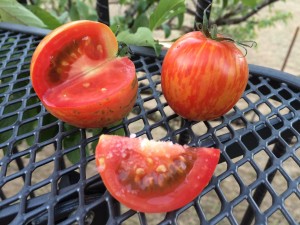Only two things that money can’t buy…
that’s true love and homegrown tomatoes. – Guy Clark
So it’s August. In Peru, it’s the dead of winter. But for the 88 percent of the world’s population that lives north of the equator, we’re in the dog days of summer.
Seeing as the entire world hasn’t been getting any cooler, most of us are doing a lot of sweating. This means we need to hydrate and replace lost electrolytes, particularly sodium, but also potassium, calcium, and magnesium.
The following recipe is a great snack when you’ve been working and sweating in the summer heat. I use the term “recipe” very loosely. The recipe consists of the following steps:
- Take a tomato.
- Slice a wedge out of it.
- Sprinkle a pinch of finishing salt on the wedge.
- Eat the wedge.

So, yes, I’ve told you nothing that you didn’t already know. We all know this simple combination hits the spot when we’ve been sweating. But here are a few points you may find interesting:
Obviously, everyone is different, and the weather plays a huge factor. But in hot weather, an athlete can often lose 2-4 lbs of sweat/hr (roughly 1-2 quarts).
The primary electrolyte that we get from food is sodium, and this is also the primary electrolyte lost through sweat. As a rough average, sweat contains 500 mg of sodium per pound, so our athlete is losing 1-2 grams of salt per hour. If he or she keeps it up for, say, 2 hours, then 2-4 grams of sodium need to be replaced.
Hopefully our athlete has continued to take in fluids while exercising, so most of the 1/2 to 1 gallon of lost water has already been replenished.
A typical good-sized tomato might weigh 1/3 of a pound (~150 grams). Tomatoes are usually around 94-95% water – so just eating the tomato itself provides about 2/3 cup of water. Eating lots of hydrating foods after exercising is important.
A pinch of salt (~400 mg) will contain around 160 mg of sodium. So, let’s say you’ve sliced your tomato in 6 wedges, and added a pinch to each one. You’ve regained nearly a gram of lost sodium. (The tomato itself don’t contain much sodium).
In addition to sodium, potassium is a vital electrolyte. Here Sacred Valley Salt is a great option as your finishing salt (aside from the great flavor and texture) since it also contains potassium. But the lions’s share is of potassium comes from the tomato itself, which will likely provide around 300 mg. Sacred Valley Salt and tomatoes both also contain calcium and magnesium (other necessary electrolytes) but in smaller quantities.
Bottom line – if you’ve been working and sweating, salt and tomatoes complement each other very nicely, from the standpoint of both flavor and nutrition. I, of course, highly recommend Sacred Valley Salt. And if you can get your hands on some high-quality heirloom tomatoes, you won’t be disappointed.









